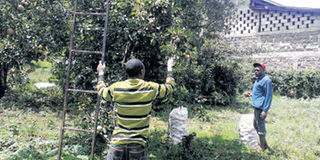In-season pears have kept my income tap flowing for 10 years

A group of youths harvest pears from a farm in Kiambu. PHOTO | KIHU IRIMU | NATION MEDIA GROUP
What you need to know:
- The 80 pears trees surrounded by thick undergrowth on Karanja Mirari’s eight acres at Bibirioni near Limuru make the farm ever-green.
- Pears, the deciduous tree that grows up to 60ft tall and produces brownish fruit with sweet fleshy white inside with small hard seeds, was first introduced in Kenya from the UK in the cool climatic area of Limuru by Christian missionaries in the 1920s.
- Like other farmers, Karanja offers wholesale price to cut down on the costs of labour for pickers, packaging the transport to towns and the headache of looking for the market or having to return the fruits to farm if they are not bought.
The tall tree spreads its dark green-leafed branches wide, outgrowing its stem to form a broad base with a pointed top looking like a gigantic hut in the middle of a garden.
Its enormity exerts such magnetic pull on countless plants that jostle for space under the warmth of its caring wings.
The 80 pears trees surrounded by thick undergrowth on Karanja Mirari’s eight acres at Bibirioni near Limuru make the farm ever-green.
“Unlike other huge trees suffocating smaller plants, pears flourish interdependently with other crops, especially napier grass, maize, potatoes, vegetables and carrots,” Mirari tells me as we savour the beauty of the farm.
Pears, the deciduous tree that grows up to 60ft tall and produces brownish fruit with sweet fleshy white inside with small hard seeds, was first introduced in Kenya from the UK in the cool climatic area of Limuru by Christian missionaries in the 1920s.
“We grew up seeing, eating it and feeding the cows with it only to realise its real value beyond the homestead about 10 years ago,” recalls Mirari.
But as urban population grew, its demand increased, yet land demarcation into smaller plots stood on the way of the farmers who would have grown it in plenty. Community lost interest in growing it, leading to slow decline and in some areas near-extinction of the once ubiquitous pear tree because need for money saw most of the land set aside for carrots and cabbages that take shorter time to harvest.
The price of a fruit that weighs 250g has risen from 50 cents to Sh10 in the last five years and it can fetch up to Sh15 in warmer areas like Kajiado, Machakos and Mombasa, a fact which the Kimende agricultural extension officer Alex Njenga says is not acknowledged by local farmers who have formed cooperatives to cut off brokers who handle 90 per cent of their produce.
From each of the 80 trees, Karanja, 62, harvests between 100 and 200 quality fruits between February and April. He is a direct beneficiary of the rising demand for the fruit in Nairobi, Nakuru and other towns which has seen aggressive buyers roaming the farms “even before the fruits ripen offering varying prices”. But Karanja calls various contacts to get the prevailing prices before settling on any offer.
Like other farmers, Karanja offers wholesale price to cut down on the costs of labour for pickers, packaging the transport to towns and the headache of looking for the market or having to return the fruits to farm if they are not bought.
“I get about Sh100,000 per harvest from all the trees. The harvests come after every five or so weeks within February to April. We agree with the buyer to select only the ripe fruits,” says Karanja, who has been growing the crop for 10 years.
Apart from Bibirioni, pears also do well in Kimende, Molo, Limuru, Buchi and some parts of Murang’a.
Mirari, a retired education officer who worked at the Museums of Kenya and the author of Biological Techniques published by ICIPE Press and Appreciating Evaluation (Kenya Institute of Education), says pears have opened the eyes of the local community to fruit farming.
The former member of the board of the Commonwealth Museums, now in full-time farming, grows other crops and keeps dairy cows on the farm but rates pears highly “for offering me the much-needed consistent income every year after retirement”.
Bibirioni is also a beehive of activity for the youth who get casual jobs to harvest pears at Sh400 per day. “Over 2,000 youth converge in Bibirioni in the harvest period to earn a living,” says Mirari.
Pears, which are planted from seedlings and take four years to mature, can remain productive for 40 years. They require little care. They only need occasional spraying to control bacteria.



